The Metallogenic Setting of the Jiangjiatun Mo Deposit, North China: Constraints from a Combined Zircon U–Pb and Molybdenite Re–Os Isotopic Study
Abstract
1. Introduction
2. Geological Setting
3. Deposit Geology
4. Sampling and Analytical Methods
4.1. Zircon U–Pb Dating
4.2. Molybdenite Re–Os Dating
5. Results
5.1. Zircon U–Pb Dating
5.2. Molybdenite Re–Os Isotopic Dating
6. Discussion
6.1. Timing of Mo Mineralization at Jiangjiatun
6.2. Crust-Mantle Interaction Process Indicated by Re Concentrations in Molybdenite
6.3. Tectonic Evolution and Metallogenic Setting of the YLMB
7. Conclusions
Author Contributions
Funding
Acknowledgments
Conflicts of Interest
References
- Chen, Y.J.; Pirajno, F.; Li, N.; Deng, X.H. Molybdenum deposits in China. Ore Geol. Rev. 2017, 81, 401–404. [Google Scholar] [CrossRef]
- Mao, J.W.; Pirajno, F.; Xiang, J.F.; Gao, J.J.; Ye, H.S.; Li, Y.F.; Guo, B.J. Mesozoic molybdenum deposits in the east Qinling–Dabie orogenic belt: Characteristics and tectonic settings. Ore Geol. Rev. 2011, 43, 264–293. [Google Scholar] [CrossRef]
- Wang, G.G.; Ni, P.; Yu, W.; Chen, H.; Jiang, L.L.; Wang, B.H.; Zhang, H.D.; Li, P.F. Petrogenesis of Early Cretaceous post-collisional granitoids at Shapinggou, Dabie Orogen: Implications for crustal architecture and porphyry Mo mineralization. Lithos 2014, 184–187, 393–415. [Google Scholar] [CrossRef]
- Zeng, Q.; Liu, J.; Qin, K.; Fan, H.; Chu, S.; Wang, Y.; Zhou, L. Types, characteristics, and time–space distribution of molybdenum deposits in China. Int. Geol. Rev. 2013, 55, 1311–1358. [Google Scholar] [CrossRef]
- Dai, J.Z.; Mao, J.W.; Yang, F.Q.; Ye, H.S.; Zhao, C.S.; Xie, G.Q.; Zhang, C.Q. Geological characteristics and geodynamic background of molybdenum (copper) deposits along Yanshan-Liaoning metallogenic belt on northern margin of North China block. Miner. Depos. 2006, 25, 598–612. (In Chinese) [Google Scholar]
- Pirajno, F.; Ernst, R.E.; Borisenko, A.S.; Fedoseev, G.; Naumov, E.A. Intraplate magmatism in Central Asia and China and associated metallogeny. Ore Geol. Rev. 2009, 35, 114–136. [Google Scholar] [CrossRef]
- Mao, J.W.; Xie, G.Q.; Zhang, Z.H.; Li, X.F.; Wang, Y.T.; Zhang, C.Q.; Li, Y.F. Mesozoic large-scale metallogenic pulses in North China and corresponding geodynamic settings. Acta Petrol. Sin. 2005, 21, 169–188. (In Chinese) [Google Scholar]
- Han, C.; Xiao, W.; Zhao, G.; Sun, M.; Qu, W.; Du, A. A Re–Os study of molybdenites from the Lanjiagou Mo deposit of North China Craton and its geological significance. Gondwana Res. 2009, 16, 264–271. [Google Scholar] [CrossRef]
- Chu, S.; Zeng, Q.; Liu, J. Re-Os and U-Pb geochronology of the Songbei porphyry-skarn Mo deposit, North China Craton: Implications for the Early Jurassic tectonic setting in eastern China. J. Geochem. Explor. 2017, 181, 256–269. [Google Scholar] [CrossRef]
- Ruan, B.; Lu, X.; Liu, S.; Yang, W. Genesis of Bianjiadayuan Pb–Zn–Ag deposit in Inner Mongolia: Constraints from U-Pb dating of zircon and multi-isotope geochemistry. Miner. Depos. 2013, 32, 501–514. (In Chinese) [Google Scholar]
- Xu, W.; Wang, F.; Pei, F.; Meng, E.; Tang, J.; Xu, M.; Wang, W. Mesozoic tectonic regimes and regional ore-forming background in NE China: Constraints from spatial and temporal variations of Mesozoic volcanic rock associations. Acta Petrol. Sin. 2013, 29, 339–353. (In Chinese) [Google Scholar]
- Zhao, G.; Cawood, P.A. Precambrian geology of China. Precambrian Res. 2012, 222–223, 13–54. [Google Scholar] [CrossRef]
- Zhao, Y.; Chen, B.; Zhang, S.; Liu, J.; Hu, J.; Liu, J.; Pei, J. Pre-Yanshanian geological events in the northern margin of the North China Craton and its adjacent areas. Geol. China 2010, 37, 900–915. (In Chinese) [Google Scholar]
- Zhao, G.; Wilde, S.A.; Cawood, P.A.; Sun, M. Archean blocks and their boundaries in the North China Craton: Lithological, geochemical, structural and P–T path constraints and tectonic evolution. Precambrian Res. 2001, 107, 45–73. [Google Scholar] [CrossRef]
- Zhao, G.; Cawood, P.A.; Li, S.; Wilde, S.A.; Sun, M.; Zhang, J.; He, Y.; Yin, C. Amalgamation of the North China Craton: Key issues and discussion. Precambrian Res. 2012, 222–223, 55–76. [Google Scholar] [CrossRef]
- Lu, S.; Zhao, G.; Wang, H.; Hao, G. Precambrian metamorphic basement and sedimentary cover of the North China Craton: A review. Precambrian Res. 2008, 160, 77–93. [Google Scholar] [CrossRef]
- Zhao, T.; Deng, X.; Hu, G.; Zhou, Y.; Peng, P.; Zhai, M. The Paleoproterozoic-Mesoproterozoic boundary of the North China Craton and the related geological issues: A review. Acta Petrol. Sin. 2015, 31, 1495–1508. (In Chinese) [Google Scholar]
- Wu, F.Y.; Yang, J.H.; Zhang, Y.B.; Liu, X.M. Emplacement ages of the Mesozoic granites in southeastern part of the Western Liaoning Province. Acta Petrol. Sin. 2006, 22, 315–325. (In Chinese) [Google Scholar]
- Shu, Q.; Chang, Z.; Lai, Y.; Zhou, Y.; Sun, Y.; Yan, C. Regional metallogeny of Mo-bearing deposits in northeastern China, with new Re–Os dates of porphyry Mo deposits in the Nothern Xilamulun District. Econ. Geol. 2016, 111, 1783–1798. [Google Scholar] [CrossRef]
- Xu, X.; Zhang, X.; Zheng, C.; Cui, F.; Gao, Y.; Gao, F. Geochemistry and Chronology Characteristics of the Intrusive Rocks and Its Relationship with Mineralization in Yangjiazhangzi Area, the Western Liaoning Province. Journal of Jilin University. Earth Sci. Ed. 2015, 45, 804–819. [Google Scholar]
- Meng, Q.R.; Wei, H.H.; Wu, G.L.; Duan, L. Early Mesozoic tectonic settings of the northern North China craton. Tectonophysics 2014, 611, 155–166. [Google Scholar] [CrossRef]
- Hsu, K.J.; Wang, Q.C.; Li, L.; Hao, J. Geologic evolution of the Neimonides-A working hypothesis. Eclogae Geol. Helv. 1991, 84, 1–31. [Google Scholar]
- Quan, H. Nonferrous metallic deposits in the northern Hebei Province—Western Liaoning Province area. In Geology and Nonferrous Metallic Deposits in the Northern Margin of the North China Landmass and its Adjacent; Geological Publishing House: Beijing, China, 1994; pp. 383–471. (In Chinese) [Google Scholar]
- Xu, H.; Liu, Y.-Q.; Kuang, H.-W.; Liu, Y.-X.; Peng, N. Jurassic–Cretaceous terrestrial transition red beds in northern North China and their implication on regional paleogeography, paleoecology, and tectonic evolution. Palaeoworld 2017, 26, 403–422. [Google Scholar] [CrossRef]
- Liang, S.; Liu, J.; Zhang, Y.; Zhai, F.; Wang, G.; He, G. Liaoxi Hongluoshan-Wuzhishan area molybdenum polymetallic deposits conditions, ore analysis and metallogenic prediction. J. Northwest Univ. Nat. Sci. Ed. 2014, 44, 461–468. (In Chinese) [Google Scholar]
- Davis, G.A.; Zheng, Y.; Wang, C.; Darby, B.J.; Zhang, C.; Gehrels, G. Mesozoic tectonic evolution of the Yanshan fold and thrust belt, with emphasis on Hebei and Liaoning provinces, Northern China. In Paleozoic and Mesozoic Tectonic Evolution of Central Asia: From Continental Assembly to Intracontinental Deformation; Hendrix, M.S., Davis, G.A., Eds.; Geological Society of America: Boulder, CO, USA, 2001; pp. 71–197. [Google Scholar] [CrossRef]
- Chen, Y.J.; Zhang, C.; Wang, P.; Pirajno, F.; Li, N. The Mo deposits of Northeast China: A powerful indicator of tectonic settings and associated evolutionary trends. Ore Geol. Rev. 2017, 81, 602–640. [Google Scholar] [CrossRef]
- Initial Geological Report on the Jiangjiatun Mo Deposit; 242 Brigade Liaoning Province Nuclear Industry Geology Bureau: Jinzhou, China, 2006; unpublished.
- Zong, K.; Klemd, R.; Yuan, Y.; He, Z.; Guo, J.; Shi, X.; Liu, Y.; Hu, Z.; Zhang, Z. The assembly of Rodinia: The correlation of early Neoproterozoic (ca. 900 Ma) high-grade metamorphism and continental arc formation in the southern Beishan Orogen, southern Central Asian Orogenic Belt (CAOB). Precambrian Res. 2017, 290, 32–48. [Google Scholar] [CrossRef]
- Hu, Z.; Zhang, W.; Liu, Y.; Gao, S.; Li, M.; Zong, K.; Chen, H.; Hu, S. “Wave” signal-smoothing and mercury-removing device for laser ablation quadrupole and multiple collector ICPMS analysis: Application to lead isotope analysis. Anal. Chem. 2015, 87, 1152–1157. [Google Scholar] [CrossRef]
- Wiedenbeck, M.; Hanchar, J.M.; Peck, W.H.; Sylvester, P.; Valley, J.; Whitehouse, M.; Kronz, A.; Morishita, Y.; Nasdala, L.; Fiebig, J.; et al. Further characterisation of the 91500 zircon crystal. Geostand. Geoanal. Res. 2004, 28, 9–39. [Google Scholar] [CrossRef]
- Jackson, S.E.; Pearson, N.J.; Griffin, W.L.; Belousova, E.A. The application of laser ablation-inductively coupled plasma-mass spectrometry to in situ U–Pb zircon geochronology. Chem. Geol. 2004, 211, 47–69. [Google Scholar] [CrossRef]
- Pearce, N.J.G.; Perkins, W.T.; Westgate, J.A.; Gorton, M.P.; Jackson, S.E.; Neal, C.R.; Chenery, S.P. A Compilation of New and Published Major and Trace Element Data for NIST SRM 610 and NIST SRM 612 Glass Reference Materials. Geostand. Newsl. 1997, 21, 115–144. [Google Scholar] [CrossRef]
- Liu, Y.; Gao, S.; Hu, Z.; Gao, C.; Zong, K.; Wang, D. Continental and Oceanic Crust Recycling-induced Melt-Peridotite Interactions in the Trans-North China Orogen: U-Pb Dating, Hf Isotopes and Trace Elements in Zircons from Mantle Xenoliths. J. Petrol. 2010, 51, 537–571. [Google Scholar] [CrossRef]
- Ludwig, K.R. User’s Manual for Isoplot/Ex, Version 3.00, A Geochronological Toolkit for Microsoft Excel; Berkeley Geochronology Center Special Publication: Berkeley, CA, USA, 2003. [Google Scholar]
- Du, A.D.; Wu, S.Q.; Sun, D.Z.; Wang, S.X.; Qu, W.J.; Markey, R.; Stain, H.; Morgan, J.; Malinovskiy, D. Preparation and certification of Re–Os dating reference materials: Molybdenites HLP and JDC. Geostand. Geoanal. Res. 2004, 28, 41–52. [Google Scholar] [CrossRef]
- Li, C.; Qu, W.J.; Zhou, L.M.; Du, A.D. Rapid Separation of Osmium by Direct Distillation with Carius Tube. Rock Miner. Anal. 2010, 29, 14–16. (In Chinese) [Google Scholar]
- Smoliar, M.I.; Walker, R.J.; Morgan, J.W. Re-Os ages of group IIA, IIIA, IVA, and IVB iron meteorites. Science 1996, 271, 1099–1102. [Google Scholar] [CrossRef]
- Stein, H.J.; Markey, R.J.; Morgan, J.W.; Du, A.; Sun, Y. Highly precise and accurate Re–Os ages for molybdenite from the East Qinling molybdenum belt, Shaanxi Province, China. Econ. Geol. 1997, 92, 827–835. [Google Scholar] [CrossRef]
- Jiang, S.H.; Liang, Q.L.; Bagas, L. Re–Os ages for molybdenum mineralization in the Fengning region of northern Hebei Province, China: New constraints on the timing of mineralization and geodynamic setting. J. Asian Earth Sci. 2014, 79, 873–883. [Google Scholar] [CrossRef]
- Zeng, Q.; Chu, S.; Liu, J.; Sun, S.; Chen, W. Mineralization, alteration, structure, and Re–Os age of the Lanjiagou porphyry Mo deposit, North China Craton. Int. Geol. Rev. 2012, 54, 1145–1160. [Google Scholar] [CrossRef]
- Duan, H.C.; Qin, Z.Y.; Lin, X.H.; Zhang, B.H.; Liu, X.W.; Zhang, X.; Guo, P.Z.; Han, F.; Qin, L.; Dai, J.Z. Zircon U-Pb ages of intrusive bodies in Dacaoping molybdenum ore district, Fengning County, Hebei Province. Miner. Depos. 2007, 26, 634–642. (In Chinese) [Google Scholar]
- Zhang, T.; Chen, Z.Y.; Xu, L.Q.; Chen, Z.H. The Re-Os Isotopic Dating of Molybdenite from the Dasuji Molybdenum Deposit in Zhuozi County of Inner Mongolia and Its Geological Significance. Rock Miner. Anal. 2009, 28, 279–282. (In Chinese) [Google Scholar]
- Liu, Y.; Nie, F.; Fang, J. Isotopic age dating of the alkaline intrusive complex and its related molybdenum polymetallic deposit at Hekanzi, western Liaoning Province. Miner. Depos. 2012, 31, 1326–1336. (In Chinese) [Google Scholar]
- Zheng, Y.; Feng, H.; Wu, C.; Gu, L.; Liu, S.; He, K. Influence of crude oil on the genesis of the Lanjiagou porphyry molybdenum deposit, western Liaoning Province, China. Ore Geol. Rev. 2014, 60, 1–13. [Google Scholar] [CrossRef]
- Chen, Y.; Zhang, C.; Li, N.; Yang, Y.; Deng, K. Geology of the Mo Deposits in Northeast China. Journal of Jilin University. Earth Sci. Ed. 2012, 42, 1223–1268. (In Chinese) [Google Scholar]
- Huang, D.H. Metallochronlogy of molybdenum(-copper) deposits in the North China Craton: Re–Os age of molybdenite and its geological significance. Miner. Depos. 1996, 15, 365–373. [Google Scholar]
- Li, Q.; Meng, X.; Yang, F.; Wu, F.; Wang, L.; Hu, H.; Liu, F.; Zhang, Z. Re–Os ages of molybdenite from the Sibozi-Liubozi molybdenum-copper deposit in Qinglong County of Hebei Province and Its Implications for Metallogeny. Geol. China 2012, 39, 1622–1634. [Google Scholar]
- Feng, H.; Wu, C.; Zheng, Y.; Gu, L.; Jiang, S.; Sun, H.; Gao, L. Geochronology, Geochemistry and Petrogenic & Metallogenic Settings of the Yangmadian Porphyry Molybdenum Deposit in the Yanshan-Liaoning Metallogenic Belt, North China. J. Jilin Univ. (Earth Sci. Ed.) 2012, 42, 1711–1729. [Google Scholar]
- Dai, J.; Mao, J.; Zhao, C.; Me, G.; Yang, F.; Wang, Y. New U–Pb and Re–Os age data and the geodynamic setting of the Xiaojiayingzi Mo (Fe) deposit, western Liaoning province, Northeastern China. Ore Geol. Rev. 2009, 35, 235–244. [Google Scholar] [CrossRef]
- Wu, H.; Zhang, L.; Pirajno, F.; Shu, Q.; Zhang, M.; Zhu, M.; Xiang, P. The Mesozoic Caosiyao giant porphyry Mo deposit in Inner Mongolia, North China and Paleo-Pacific subduction-related magmatism in the northern North China Craton. J. Asian Earth Sci. 2016, 127, 281–299. [Google Scholar] [CrossRef]
- Dong, G.; Santosh, M.; Li, S.; Shen, J.; Mo, X.; Scott, S.; Qu, K.; Wang, X. Mesozoic magmatism and metallogenesis associated with the destruction of the North China Craton: Evidence from U–Pb geochronology and stable isotope geochemistry of the Mujicun porphyry Cu-Mo deposit. Ore Geol. Rev. 2013, 53, 434–445. [Google Scholar] [CrossRef]
- Song, Y.; Ding, H.Y.; Qu, X.M.; Wang, R.J.; Zhou, W.; Wang, S.Z. Re–Os and U–Pb Geochronology of the Dawan Mo-Zn-Fe Deposit in Northern Taihang Mountains, China. Resour. Geol. 2014, 64, 117–135. [Google Scholar] [CrossRef]
- Du, B.; Wei, J.; Wang, Q.; Li, Y.; Liu, G.; Yu, H.; Liu, Y. Discussion on metallogenic setting and time difference between magmatism and mineralization of molybdenum deposits in East China. Miner. Depos. 2010, 29, 935–955. [Google Scholar]
- Dai, X.; Peng, X.; Hu, X. Adakite in Xiaosigou porphyry copper-molybdenum deposit, Hebei Province: Age, geochemical characteristics and geological implications. Miner. Depos. 2010, 29, 517–528. [Google Scholar]
- Zhang, Z.Z.; Wu, C.Z.; Gu, L.X.; Feng, H.; Zheng, Y.C.; Huang, J.H.; Li, J.; Sun, Y.L. Molybdenite Re–Os dating of Xintaimen molybdenum deposit in Yanshan-Liaoning metallogenic belt, North China. Miner. Depos. 2009, 28, 313–320. (In Chinese) [Google Scholar]
- Stein, H.J.; Markey, R.J.; Morgan, J.W.; Hannah, J.L.; Schersten, A. The remarkable Re–Os chronometer in molybdenite: How and why it works. Terra Nova 2001, 13, 479–486. [Google Scholar] [CrossRef]
- Mao, J.; Zhang, Z.; Zhang, Z.; Du, A. Re–Os isotopic dating of molybdenites in the Xiaoliugou W (Mo) deposit in the northern Qilian mountains and its geological significance. Geochim. Cosmochim. Acta 1999, 63, 1815–1818. [Google Scholar] [CrossRef]
- Mao, J.; Wang, Y.; Lehmann, B.; Yu, J.; Du, A.; Mei, Y.; Li, Y.; Zang, W.; Stein, H.J.; Zhou, T. Molybdenite Re–Os and albite 40Ar/39Ar dating of Cu–Au–Mo and magnetite porphyry systems in the Yangtze River valley and metallogenic implications. Ore Geol. Rev. 2006, 29, 307–324. [Google Scholar] [CrossRef]
- Eizenhoefer, P.R.; Zhao, G.; Zhang, J.; Sun, M. Final closure of the Paleo-Asian Ocean along the Solonker Suture Zone: Constraints from geochronological and geochemical data of Permian volcanic and sedimentary rocks. Tectonics 2014, 33, 441–463. [Google Scholar] [CrossRef]
- Chen, B.; Jahn, B.M.; Wilde, S.; Xu, B. Two contrasting paleozoic magmatic belts in northern Inner Mongolia, China: Petrogenesis and tectonic implications. Tectonophysics 2000, 328, 157–182. [Google Scholar] [CrossRef]
- Xiao, W.J.; Windley, B.F.; Huang, B.C.; Han, C.M.; Yuan, C.; Chen, H.L.; Sun, M.; Sun, S.; Li, J.L. End-Permian to mid-Triassic termination of the accretionary processes of the southern Altaids: Implications for the geodynamic evolution, Phanerozoic continental growth, and metallogeny of Central Asia. Int. J. Earth Sci. 2009, 98, 1189–1217. [Google Scholar] [CrossRef]
- Liu, Y.; Li, W.; Feng, Z.; Wen, Q.; Neubauer, F.; Liang, C. A review of the Paleozoic tectonics in the eastern part of Central Asian Orogenic Belt. Gondwana Res. 2017, 43, 123–148. [Google Scholar] [CrossRef]
- Davis, G.A.; Xu, B.; Zheng, Y.D.; Zhang, W.J. Indosinian extension in the Solonker suture zone: The Sonid Zuoqi metamorphic core complex, Inner Mongolia, China. Earth Sci. Front. 2004, 11, 135–144. [Google Scholar]
- Ritts, B.D.; Darby, B.J.; Cope, T. Early Jurassic extensional basin formation in the Daqing Shan segment of the Yinshan belt, northern North China Block, Inner Mongolia. Tectonophysics 2001, 339, 239–258. [Google Scholar] [CrossRef]
- Zhang, S.H.; Zhao, Y.; Liu, X.C.; Liu, D.Y.; Chen, F.; Xie, L.W.; Chen, H.H. Late Paleozoic to Early Mesozoic mafic–ultramafic complexes from the northern North China Block: Constraints on the composition and evolution of the lithospheric mantle. Lithos 2009, 110, 229–246. [Google Scholar] [CrossRef]
- Zhang, S.H.; Zhao, Y.; Ye, H.; Hou, K.J.; Li, C.F. Early Mesozoic alkaline complexes in the northern North China Craton: Implications for cratonic lithospheric destruction. Lithos 2012, 155, 1–18. [Google Scholar] [CrossRef]
- Liu, S.; Hu, R.Z.; Gao, S.; Feng, C.X.; Qi, L.; Zhang, H.; Xiao, T.F.; Qi, Y.Q.; Wang, T.; Coulson, I.M. Zircon U–Pb geochronology and major, trace elemental and Sr–Nd–Pb isotopic geochemistry of mafic dykes in westernShandong Province, east China: Constraints on their petrogenesis and geo-dynamic significance. Chem. Geol. 2008, 255, 329–345. [Google Scholar] [CrossRef]
- Darby, B.J.; Davis, G.A.; Zheng, Y.; Zhang, J.; Wang, X. Evolving geometry of the Huhhot metamorphic core complex, Inner Mongolia. China GSA Abstr. Programs 2001, 33, 32. [Google Scholar]
- Graham, S.A.; Hendrix, M.S.; Johnson, C.L.; Badamgarav, D.; Badarch, G.; Amory, J.; Porter, M.; Barsbold, R.; Webb, L.E.; Hacker, B.R. Sedimentary record and tectonic implications of Mesozoic rifting in southeast Mongolia. Geol. Soc. Am. Bull. 2001, 113, 1560–1579. [Google Scholar] [CrossRef]
- Xu, C.; Zhang, L.; Shi, H.; Brix, M.R.; Huhma, H.; Chen, L.; Zhang, M.; Zhou, Z. Tracing an Early Jurassic magmatic arc from South to East China Seas. Tectonics 2017, 36, 466–492. [Google Scholar] [CrossRef]
- Isozaki, Y. Jurassic accretion tectonics of Japan. Isl. Arc 1997, 6, 25–51. [Google Scholar] [CrossRef]
- Wu, F.Y.; Yang, J.H.; Lo, C.H.; Wilde, S.A.; Sun, D.Y.; Jahn, B.M. The Heilongjiang Group: A Jurassic accretionary complex in the Jiamusi Massif at the western Pacific margin of northeastern China. Isl. Arc 2007, 16, 156–172. [Google Scholar] [CrossRef]
- Luo, Z.H.; Wei, Y.; Xin, H.T.; Ke, S.; Li, W.T.; Li, D.D.; Huang, J.X. The Mesozoic intraplate orogeny of the Taihang Mountains and the thinning of the continental lithosphere in North China. Earth Sci. Front. 2006, 13, 52–63. [Google Scholar]
- Zhang, C.; Li, C.; Deng, H.; Liu, Y.; Liu, L.; Wei, B.; Li, H.; Liu, Z. Mesozoic contraction deformation in the Yanshan and northern Taihang mountains and its implications to the destruction of the North China Craton. Sci. China Earth Sci. 2011, 54, 798–822. [Google Scholar] [CrossRef]
- Wang, G.G.; Ni, P.; Zhao, C.; Wang, X.L.; Li, P.; Chen, H.; Zhu, A.D.; Li, L. Spatiotemporal reconstruction of Late Mesozoic silicic large igneous province and related epithermal mineralization in South China: Insights from the Zhilingtou volcanic-intrusive complex. J. Geophys. Res. Solid Earth 2016, 121, 7903–7928. [Google Scholar] [CrossRef]
- Wang, G.G.; Ni, P.; Yao, J.; Wang, X.L.; Zhao, K.D.; Zhu, R.Z.; Xu, Y.F.; Pan, J.Y.; Li, L.; Zhang, Y.H. The link between subduction-modified lithosphere and the giant Dexing porphyry copper deposit, South China: Constraints from High-Mg adakitic rocks. Ore Geol. Rev. 2015, 67, 109–126. [Google Scholar] [CrossRef]
- Wang, G.G.; Ni, P.; Zhao, K.D.; Wang, X.L.; Liu, J.Q.; Jiang, S.Y.; Chen, H. Petrogenesis of the Middle Jurassic Yinshan volcanic-intrusive complex, SE China: Implications for tectonic evolution and Cu-Au mineralization. Lithos 2012, 150, 135–154. [Google Scholar] [CrossRef]
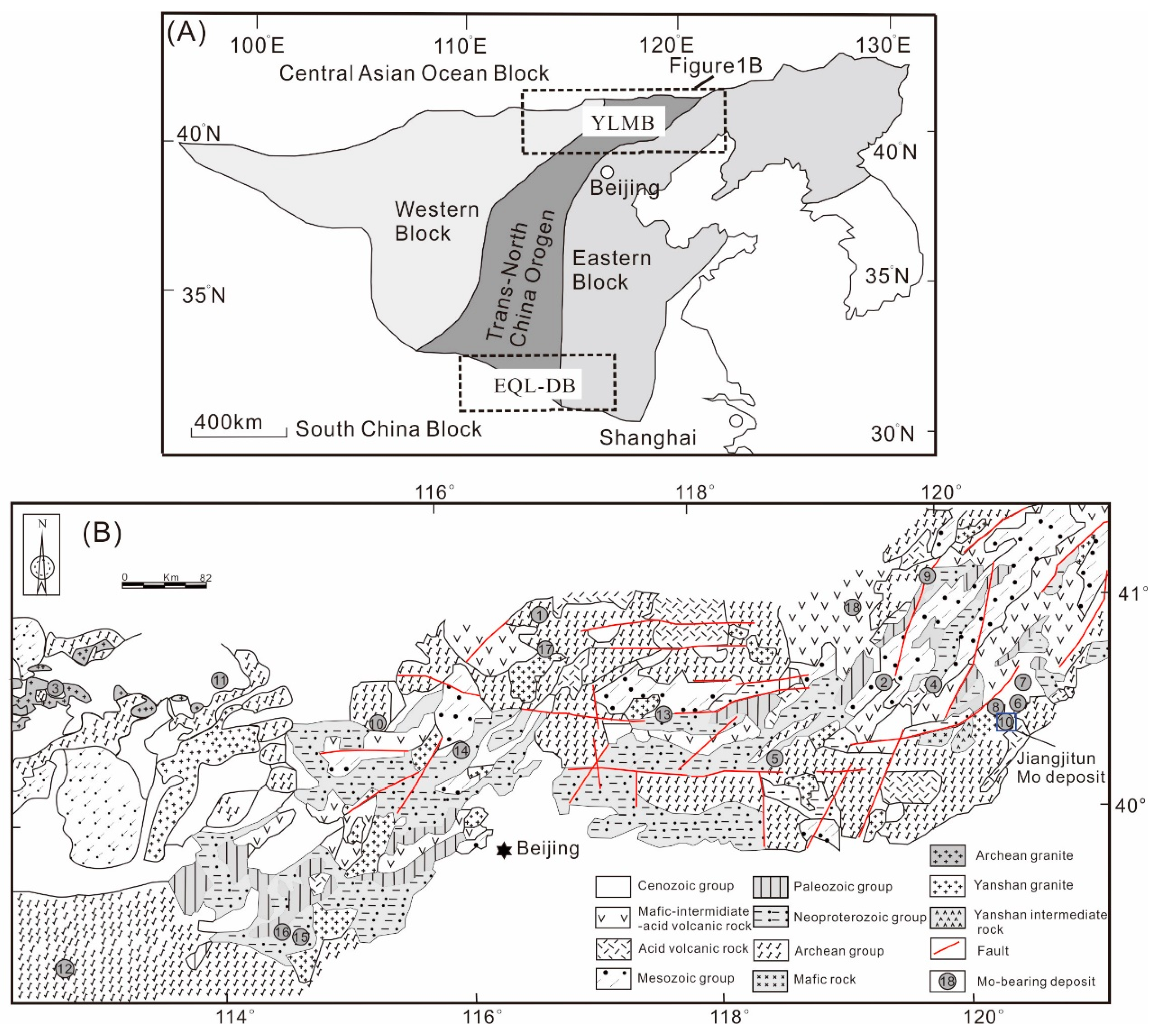
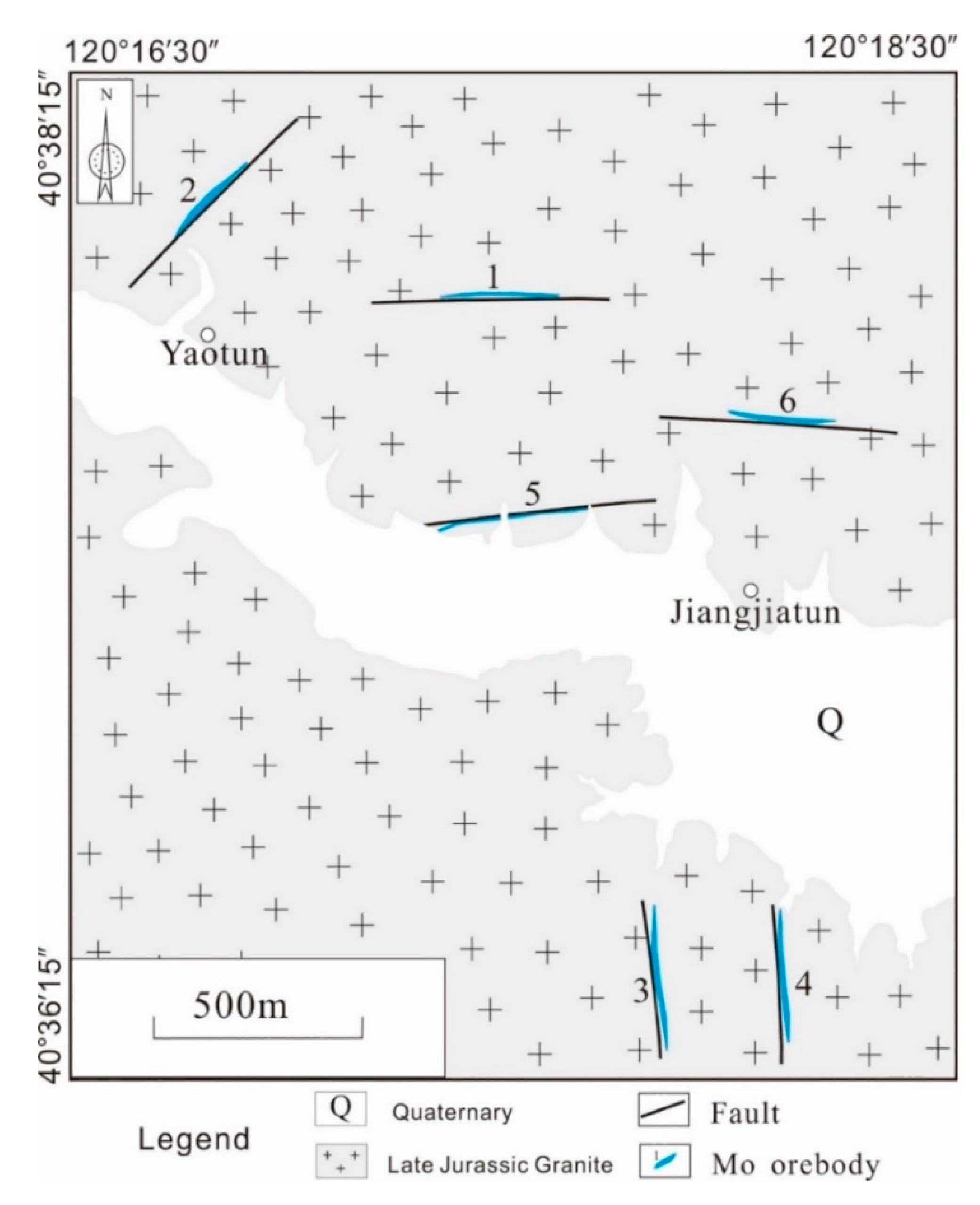
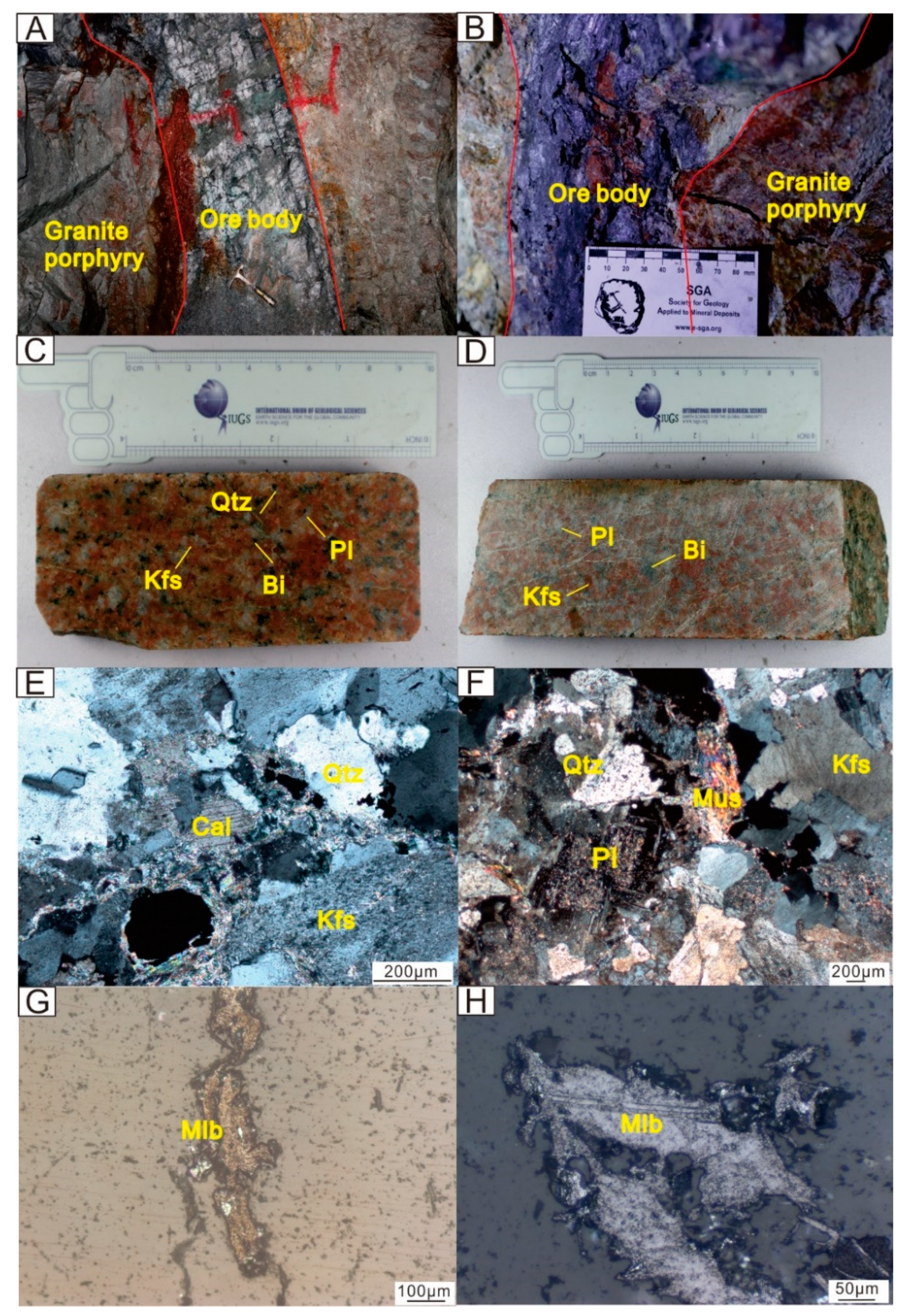
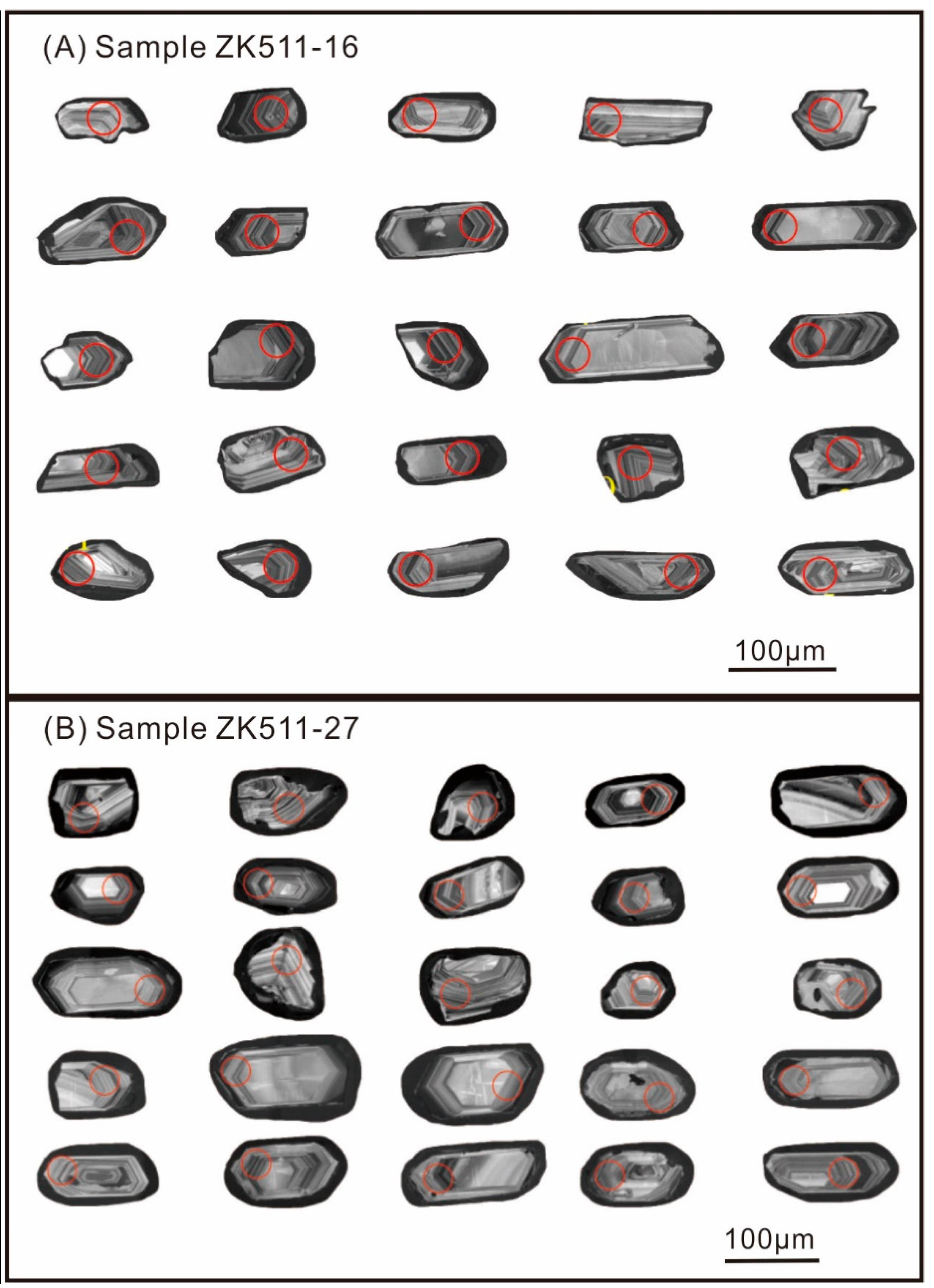

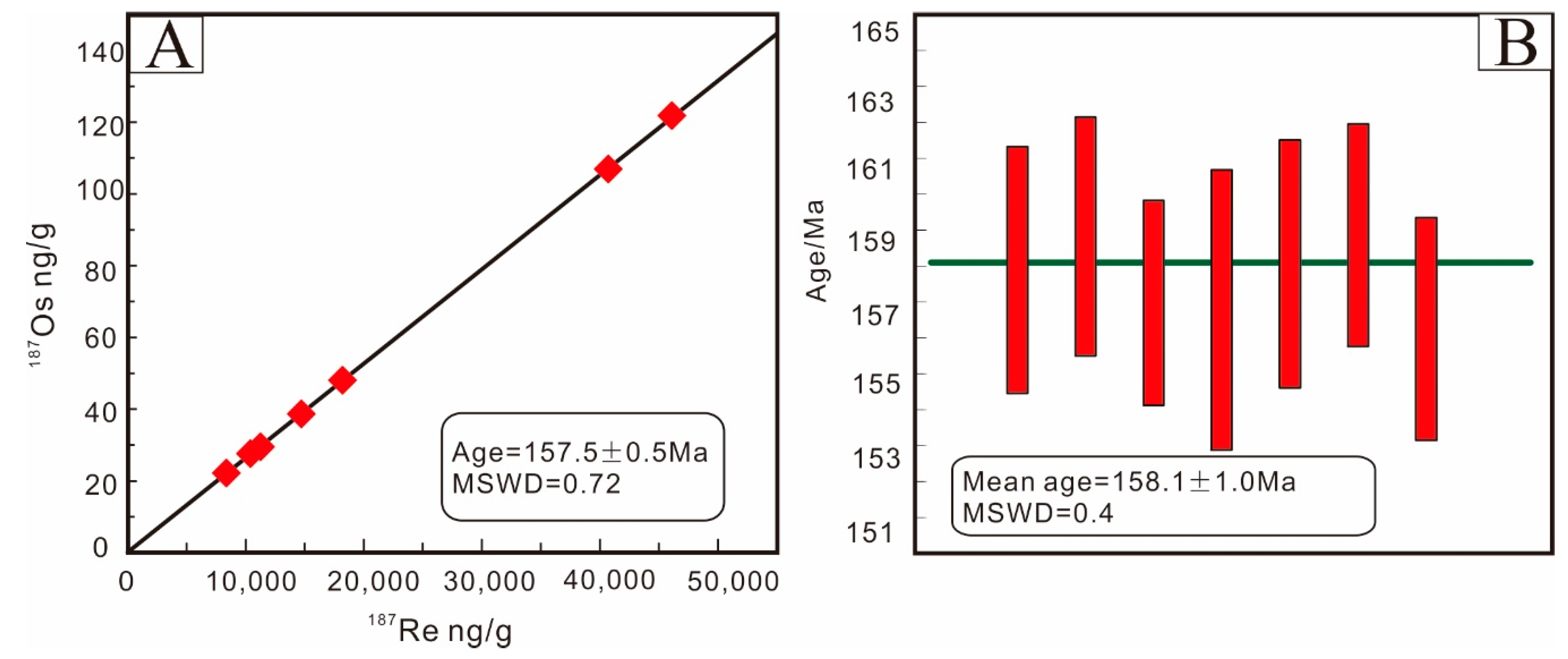
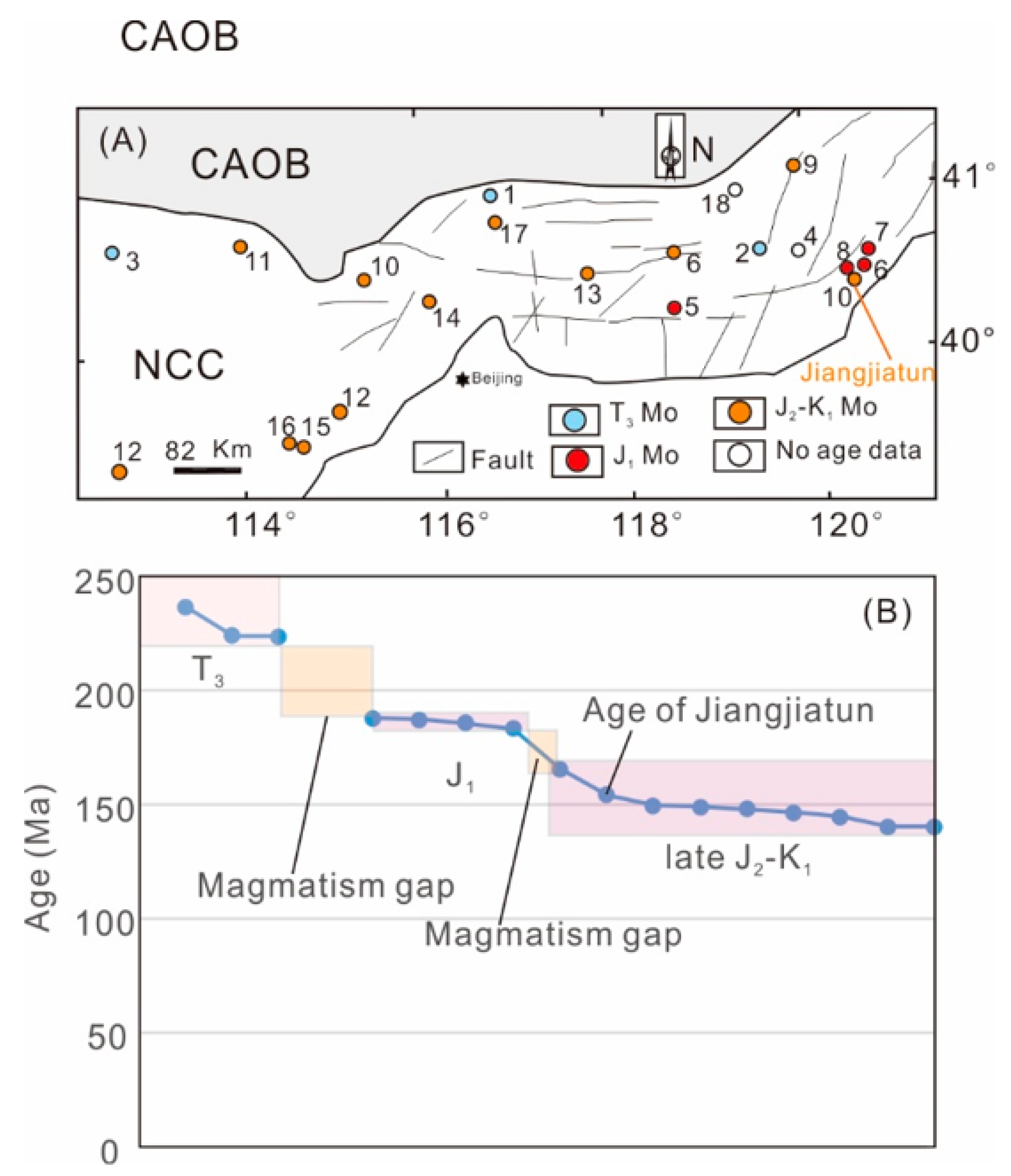
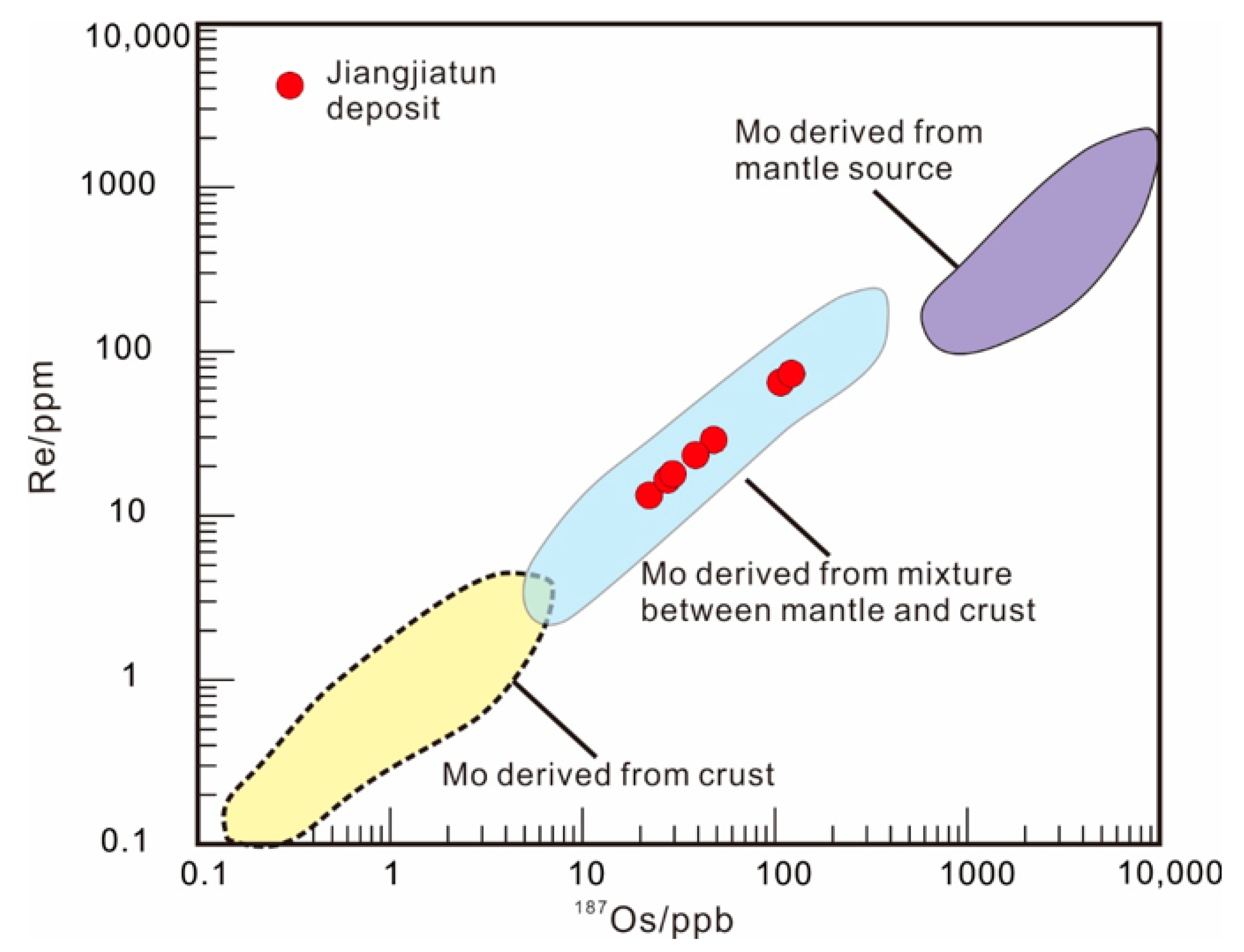
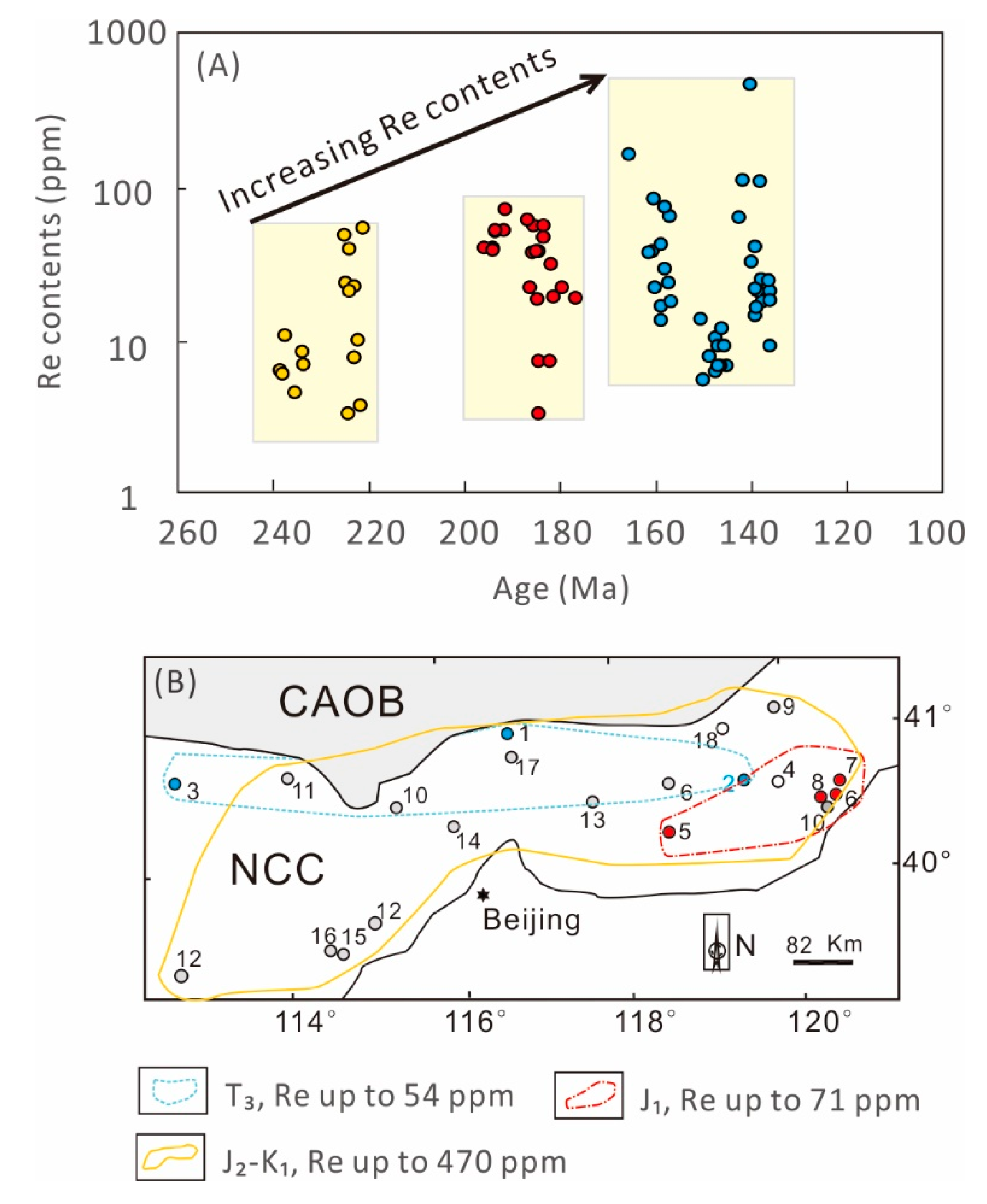

| SPOT | Th | U | Th/U | 207Pb/235U | 1σ | 206Pb/238U | 1σ | 207Pb/235U | 1σ | 206Pb/238U | 1σ |
|---|---|---|---|---|---|---|---|---|---|---|---|
| Sample Number 511-16 | |||||||||||
| 1 | 111 | 179 | 0.62 | 0.16396 | 0.00748 | 0.02458 | 0.0005 | 154 | 7 | 157 | 3 |
| 2 | 698 | 1146 | 0.61 | 0.16712 | 0.00382 | 0.02443 | 0.0003 | 157 | 3 | 156 | 2 |
| 3 | 136 | 191 | 0.71 | 0.15878 | 0.00876 | 0.02428 | 0.00041 | 150 | 8 | 155 | 3 |
| 4 | 131 | 290 | 0.45 | 0.16932 | 0.00759 | 0.02444 | 0.00044 | 159 | 7 | 156 | 3 |
| 5 | 137 | 245 | 0.56 | 0.16127 | 0.00818 | 0.0246 | 0.00036 | 152 | 7 | 157 | 2 |
| 6 | 612 | 723 | 0.85 | 0.16716 | 0.00442 | 0.0236 | 0.00031 | 157 | 4 | 150 | 2 |
| 7 | 547 | 658 | 0.83 | 0.1637 | 0.00416 | 0.02418 | 0.00031 | 154 | 4 | 154 | 2 |
| 8 | 734 | 735 | 1 | 0.16971 | 0.00497 | 0.02439 | 0.00035 | 159 | 4 | 155 | 2 |
| 9 | 161 | 261 | 0.62 | 0.17166 | 0.00808 | 0.02492 | 0.00047 | 161 | 7 | 159 | 3 |
| 10 | 473 | 551 | 0.86 | 0.16555 | 0.00486 | 0.02394 | 0.0003 | 156 | 4 | 153 | 2 |
| 12 | 402 | 534 | 0.75 | 0.1731 | 0.00621 | 0.02452 | 0.00033 | 162 | 5 | 156 | 2 |
| 13 | 413 | 587 | 0.7 | 0.16677 | 0.00551 | 0.02371 | 0.00036 | 157 | 5 | 151 | 2 |
| 14 | 268 | 388 | 0.69 | 0.16949 | 0.00664 | 0.02435 | 0.00034 | 159 | 6 | 155 | 2 |
| 15 | 661 | 770 | 0.86 | 0.16685 | 0.0061 | 0.02401 | 0.0004 | 157 | 5 | 153 | 3 |
| 17 | 138 | 258 | 0.54 | 0.16698 | 0.00651 | 0.02407 | 0.00036 | 157 | 6 | 153 | 2 |
| 18 | 201 | 349 | 0.58 | 0.16075 | 0.00606 | 0.0243 | 0.00035 | 151 | 5 | 155 | 2 |
| 19 | 222 | 342 | 0.65 | 0.15948 | 0.00764 | 0.02483 | 0.00046 | 150 | 7 | 158 | 3 |
| 20 | 211 | 352 | 0.6 | 0.16455 | 0.00599 | 0.02354 | 0.00033 | 155 | 5 | 150 | 2 |
| 22 | 403 | 460 | 0.88 | 0.16422 | 0.0066 | 0.02433 | 0.00038 | 154 | 6 | 155 | 2 |
| 23 | 217 | 615 | 0.35 | 0.17383 | 0.00656 | 0.02436 | 0.00043 | 163 | 6 | 155 | 3 |
| 25 | 218 | 329 | 0.66 | 0.15971 | 0.0068 | 0.02421 | 0.0004 | 150 | 6 | 154 | 3 |
| Sample Number 511-27 | |||||||||||
| 1 | 252 | 266 | 0.95 | 0.16532 | 0.00756 | 0.02398 | 0.00038 | 155 | 7 | 153 | 2 |
| 3 | 482 | 407 | 1.18 | 0.16317 | 0.00598 | 0.025 | 0.00033 | 153 | 5 | 159 | 2 |
| 4 | 1153 | 949 | 1.22 | 0.16591 | 0.00485 | 0.0237 | 0.00031 | 156 | 4 | 151 | 2 |
| 5 | 763 | 1102 | 0.69 | 0.17401 | 0.00419 | 0.02425 | 0.00033 | 163 | 4 | 154 | 2 |
| 6 | 91 | 113 | 0.81 | 0.16466 | 0.0104 | 0.02457 | 0.00046 | 155 | 9 | 156 | 3 |
| 8 | 289 | 329 | 0.88 | 0.16337 | 0.00593 | 0.02481 | 0.00039 | 154 | 5 | 158 | 2 |
| 9 | 355 | 308 | 1.15 | 0.16229 | 0.00595 | 0.02397 | 0.00037 | 153 | 5 | 153 | 2 |
| 11 | 376 | 391 | 0.96 | 0.1563 | 0.00662 | 0.02416 | 0.00035 | 147 | 6 | 154 | 2 |
| 12 | 111 | 258 | 0.43 | 0.16936 | 0.00737 | 0.02439 | 0.0004 | 159 | 6 | 155 | 3 |
| 13 | 135 | 323 | 0.42 | 0.17382 | 0.00627 | 0.02435 | 0.00037 | 163 | 5 | 155 | 2 |
| 14 | 76 | 102 | 0.75 | 0.17044 | 0.01302 | 0.02419 | 0.00059 | 160 | 11 | 154 | 4 |
| 16 | 351 | 349 | 1.01 | 0.16682 | 0.00689 | 0.02398 | 0.00036 | 157 | 6 | 153 | 2 |
| 17 | 187 | 254 | 0.73 | 0.16761 | 0.0072 | 0.02414 | 0.00041 | 157 | 6 | 154 | 3 |
| 18 | 218 | 254 | 0.86 | 0.16345 | 0.00733 | 0.02359 | 0.00036 | 154 | 6 | 150 | 2 |
| 19 | 466 | 426 | 1.09 | 0.15968 | 0.00554 | 0.02356 | 0.0003 | 150 | 5 | 150 | 2 |
| 20 | 155 | 207 | 0.75 | 0.15868 | 0.00734 | 0.02419 | 0.00038 | 150 | 6 | 154 | 2 |
| 22 | 422 | 362 | 1.17 | 0.16752 | 0.00641 | 0.02399 | 0.00037 | 157 | 6 | 153 | 2 |
| 23 | 160 | 272 | 0.59 | 0.16499 | 0.0064 | 0.02412 | 0.00036 | 155 | 6 | 154 | 2 |
| 24 | 269 | 288 | 0.93 | 0.16228 | 0.00753 | 0.02446 | 0.00042 | 153 | 7 | 156 | 3 |
| 25 | 275 | 339 | 0.81 | 0.16521 | 0.00605 | 0.02429 | 0.00038 | 155 | 5 | 155 | 2 |
| Sample | Weight | Re | σ | 87Re | σ | 187Os | σ | Model Age | σ |
|---|---|---|---|---|---|---|---|---|---|
| 28,970 | 326 | 18,208 | 205 | 48.07 | 0.40 | 158.3 | 2.7 | ||
| DF4-11-2 | 0.03023 | 13,317 | 144 | 8370 | 90 | 22.20 | 0.17 | 159.0 | 2.6 |
| DF4-11-3 | 0.03035 | 23,411 | 192 | 14,714 | 121 | 38.67 | 0.24 | 157.6 | 2.2 |
| DF4-12-1 | 0.03010 | 64,789 | 1006 | 40,721 | 632 | 106.9 | 0.7 | 157.4 | 3.1 |
| DF4-12-2 | 0.03062 | 73,347 | 929 | 46,100 | 584 | 121.8 | 0.7 | 158.4 | 2.7 |
| DF4-10-2 | 0.03077 | 16,560 | 156 | 10,408 | 98 | 27.61 | 0.19 | 159.0 | 2.4 |
| DF4-10-3 | 0.05000 | 17,910 | 184 | 11,257 | 116 | 29.48 | 0.18 | 157.0 | 2.4 |
| No. | Deposit Name | Deposit Type | Host Rocks and Ages (Ma) | Molybdenite Re–Os Age (Ma) | References |
|---|---|---|---|---|---|
| 1 | Sadaigoumen | Porphyry Mo | Monzogranite (U–Pb, 227.1 ± 2.7) | 236.5 ± 2.2 | [40,42] |
| 2 | Hekanzi | Porphyry Mo–Cu | Biotite-orthoclase granite (U–Pb, 235.3 ± 1.0) | 224.0 ± 1.3 | [44] |
| 3 | Dasuji | Porphyry Mo | Granite porphyry | 223.5 ± 5.5 | [43] |
| 4 | Yangmadian | Porphyry Mo | Granite (U–Pb, 189.3 ± 3.3) | - | [49] |
| 5 | Sibozi | Porphyry Mo–Cu | Granite porphyry (U-Pb, 189.8 ± 0.7) | 187.8 ± 4.5 | [48] |
| 6 | Yangjiazhangzi | Skarn Mo | Porphyritic granite and granite porphyry | 187.0 ± 2.0 | [46,47] |
| 7 | Lanjiagou | Porphyry Mo | Porphyritic granite (U–Pb, 185.0 ± 1.8) | 185.6 ± 1.2 | [41] |
| 8 | Xintaimen | Porphyry Mo | Granite porphyry (U–Pb, 181 ± 2) | 183.0 ± 3.0 | [56] |
| 9 | Xiaojiayingzi | Skarn Mo–Fe | Diorite (U–Pb, 169.9 ± 1.4) | 165.5 ± 4.6 | [50] |
| 10 | Jiangjiatun | Quartz vein Mo | Granite porphyry (U–Pb, 1154 ± 0.5) | 158 ± 1.5 | This study |
| 11 | Caosiyao | Porphyry Mo | Granite porphyry (U–Pb, 149.8 ± 2.4) | 149.5 ± 5.3 | [51] |
| 12 | Houyu | Porphyry Mo | Quartz porphyry | 148.7 | [54] |
| 13 | Shouwangfen | Skarn Cu–Fe–Mo | Granodiorite | 148.0 ± 4.0 | [5] |
| 14 | Dazhuangke | Porphyry Mo | Quartz monzonite (U–Pb, 269 ± 3) | 146.4 ± 3.4 | [5,47] |
| 15 | Dawan | Porphyry-skarn Mo | Rhyolite porphyry | 144.4 ± 7.4 | [5,53] |
| 16 | Mujicun | Porphyry Cu–Mo | Porphyry diorite (U–Pb, 144.1 ± 1.2) | 140.3 ± 3.9 | [52] |
| 17 | Dacaoping | Porphyry Mo | Granodiorite (U–Pb, 140 ± 1.5) | 140.1 ± 3.4 | [40,42] |
| 18 | Xiaosigou | Porphyry Cu–Mo | Granite porphyry (K–Ar, 122.8 ± 2.5) | - | [55] |
| Deposit Name | Deposit Type | Re | Model Age (Ma) | Re–Os Age (Ma) | References |
|---|---|---|---|---|---|
| Sadaigoumen | Porphyry Mo | 8.36 | 234.2 | 236.5 ± 2.2 | [40,42] |
| 10.67 | 237.7 | ||||
| 6.30 | 238.9 | ||||
| 6.86 | 234 | ||||
| 5.93 | 238.4 | ||||
| 4.48 | 235.6 | ||||
| Hekanzi | Porphyry Mo | 23.4 | 225.1 | 224 ± 1.3 | [44] |
| 39.2 | 224.3 | ||||
| 54.3 | 221.5 | ||||
| 22.3 | 223.4 | ||||
| 20.9 | 224.4 | ||||
| 48.9 | 225.3 | ||||
| Dasuji | Porphyry Mo | 3.70 | 222.1 | 222.5 ± 3.2 | [43] |
| 7.61 | 223.4 | ||||
| 3.26 | 224.6 | ||||
| 10.0 | 222.5 | ||||
| Sibozi | Porphyry Mo–Cu | 51.5 | 193.9 | 194.0 ± 1.0 | [48] |
| 40.3 | 194.4 | ||||
| 51.6 | 192.1 | ||||
| 40.0 | 196 | ||||
| 38.7 | 194.4 | ||||
| 71.4 | 191.6 | ||||
| 52.1 | 193.7 | ||||
| Lanjiagou | Porphyry Mo | 18.5 | 184.9 | 185.5 ± 1.0 | [41] |
| 56.1 | 185.7 | ||||
| 3.29 | 184.8 | ||||
| 37.7 | 184.6 | ||||
| 21.8 | 186.6 | ||||
| 37.2 | 185.9 | ||||
| 61.3 | 187 | 184.7 ± 1.8 | |||
| 31.3 | 182.2 | ||||
| 55.4 | 183.8 | ||||
| 37.7 | 185.2 | ||||
| 46.8 | 183.8 | ||||
| Xintaimen | Porphyry Mo | 7.25 | 184.6 | 183.0 ± 3.0 | [56] |
| 7.28 | 182.4 | ||||
| 18.8 | 176.9 | ||||
| 19.0 | 181.6 | ||||
| 22.1 | 179.7 | ||||
| Xiaojiayingzi | Skarn Mo–Fe | 37.9 | 160.8 | 169.9 ± 1.4 | [50] |
| 37.1 | 161.8 | ||||
| 83.7 | 160.6 | ||||
| 42.4 | 159.1 | ||||
| 21.8 | 160.4 | ||||
| 163 | 165.8 | ||||
| Jiangjiatun | Quartz vein type | 28.97 | 158.3 | 154 ± 0.5 | This study |
| 13.32 | 159.0 | ||||
| 23.41 | 157.6 | ||||
| 64.79 | 157.4 | ||||
| 73.35 | 158.4 | ||||
| 16.56 | 159.0 | ||||
| 17.91 | 157.0 | ||||
| Caosiyao | Porphyry Mo | 6.22 | 147.7 | 149.5 ± 5.3 | [51] |
| 10.4 | 147.7 | ||||
| 7.72 | 149.1 | ||||
| 13.6 | 150.9 | ||||
| 5.47 | 150.3 | ||||
| 6.70 | 145.5 | 146.5 ± 0.8 | |||
| 11.9 | 146.5 | ||||
| 9.06 | 147.3 | ||||
| 6.74 | 146.6 | ||||
| 9.15 | 145.8 | ||||
| 6.72 | 147.3 | ||||
| Dawan | Porphyry-skarn Mo | 9.15 | 136.3 | 138 ± 2 | [5,53] |
| 17.7 | 137.9 | ||||
| 24.8 | 138.1 | ||||
| 21.0 | 136.2 | ||||
| 24.3 | 136.5 | ||||
| 18.1 | 136.2 | ||||
| Mojicun | Porphyry Cu–Mo | 40.5 | 139.4 | 140 ± 2.3 | [52] |
| 108 | 138.5 | ||||
| 63.2 | 142.7 | ||||
| 110 | 142.1 | ||||
| 470 | 140.4 | ||||
| Dacaoping | Porphyry Mo | 14.5 | 139.4 | 139.4 ± 0.9 | [40,42] |
| 32.5 | 140.2 | ||||
| 16.2 | 139.2 | ||||
| 20.9 | 138.9 | ||||
| 21.7 | 139.5 |
© 2019 by the authors. Licensee MDPI, Basel, Switzerland. This article is an open access article distributed under the terms and conditions of the Creative Commons Attribution (CC BY) license (http://creativecommons.org/licenses/by/4.0/).
Share and Cite
Li, M.; Zhang, X.; Han, L.; Gong, E.-P.; Wang, G.-G. The Metallogenic Setting of the Jiangjiatun Mo Deposit, North China: Constraints from a Combined Zircon U–Pb and Molybdenite Re–Os Isotopic Study. Minerals 2019, 9, 723. https://doi.org/10.3390/min9120723
Li M, Zhang X, Han L, Gong E-P, Wang G-G. The Metallogenic Setting of the Jiangjiatun Mo Deposit, North China: Constraints from a Combined Zircon U–Pb and Molybdenite Re–Os Isotopic Study. Minerals. 2019; 9(12):723. https://doi.org/10.3390/min9120723
Chicago/Turabian StyleLi, Ming, Xin Zhang, Liang Han, En-Pu Gong, and Guo-Guang Wang. 2019. "The Metallogenic Setting of the Jiangjiatun Mo Deposit, North China: Constraints from a Combined Zircon U–Pb and Molybdenite Re–Os Isotopic Study" Minerals 9, no. 12: 723. https://doi.org/10.3390/min9120723
APA StyleLi, M., Zhang, X., Han, L., Gong, E.-P., & Wang, G.-G. (2019). The Metallogenic Setting of the Jiangjiatun Mo Deposit, North China: Constraints from a Combined Zircon U–Pb and Molybdenite Re–Os Isotopic Study. Minerals, 9(12), 723. https://doi.org/10.3390/min9120723





